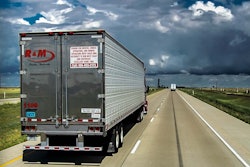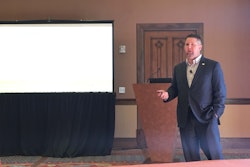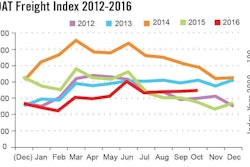 Eric Starks, CEO and chairman of FTR Transportation Intelligence.
Eric Starks, CEO and chairman of FTR Transportation Intelligence.“How do you react to a flat market?” asked trucking economist Eric Starks during the morning keynote address at the CCJ Fall Symposium, Nov. 15 in Scottsdale, Ariz.
Fleet executives and managers know what to do in a growing or declining market, he said, but the stagnant economy for the past two years “makes it very difficult.”
Starks is chief executive of FTR Transportation Intelligence, a firm that specializes in freight transportation forecasting and analysis.
FTR monitors between 50 and 100 data points on a monthly basis. Everything suggests that economic conditions will stay flat over the short term, he said. National GDP is likely to continue at between 2 and 2.5 percent, he said, and present data suggests it is about 1.5 percent.
“The data tells us we are in a very slow growth environment,” he said. Manufacturing, the lifeblood of transportation, accounts for 80 percent of freight volumes. Leading indexes show that growth in that sector has been flat for almost two years.
Orders of capital goods, an indicator of business investment, have come up slightly since hitting a trough during the summer. The bleeding has stopped for businesses, though it is unclear if investment has recovered. “But it is clear to say we have hit the bottom,” he said.
The election of Donald Trump and a Republican-controlled congress will not materially impact the economy for six to 12 months, he predicted.
Overall economic conditions point to slow and stable growth, but Starks highlighted a few positive trends:
- Fuel prices should be relatively stable over the next year.
- Business inventory-to-sales ratios are trending down from relatively high levels
- Demand in the spot freight market is the highest in the last five years, and rates have climbed back to 2015 levels. “Demand is going up but rates have not moved up materially,” he said.
- Availability of loads are “way above” historical norms and truck availability is at a fairly low level. Starks called this a “good news scenario” that “things are starting to stabilize a little.”
- Rates should increase by about 4 percent by the second half of 2017.
Turning to consumer trends, Starks says the housing market is relatively stable and new housing starts are on an upward trend. Existing home sales have leveled off over the last year, however, partly due to an increase in long-term interest rates to more than four percent from historic lows of 3.5 percent.
Retail sales are trending upwards but automotive sales will likely slow down from current highs. Auto sales hit a record 18 million in October, 2016.
Coming regulations will have the biggest impact on industry economics. Enforcement of the electronic logging device rule in December, 2017, and speed limiters and a drug and alcohol database in 2018 could create a severe capacity crisis. Starks predicted more than 100,000 drivers will be needed for the industry to keep up with demand.
Looking long term, Starks touched on driverless trucks. He predicted they will hit the road within 10 to 15 years if driverless trucks can overcome the negative public perception of their safety. He also mentioned continued “uberization” of the trucking industry using technology to automate and optimize the freight matching and tendering process.













